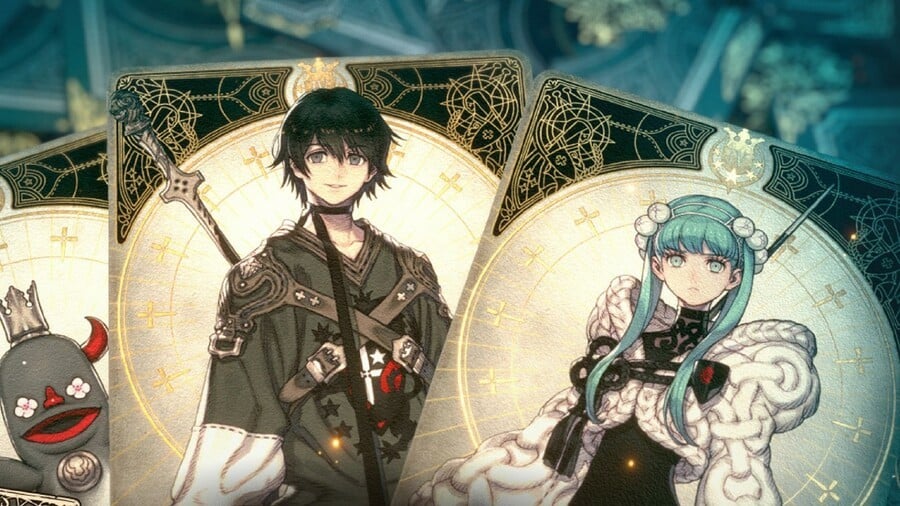
Game development these days regularly involves multiple dozens of people — sometimes hundreds or thousands — and typically games take many years of gestation before arriving. Even smaller releases from indie studios might be years in the making, which is just one of the things that makes Voice of Cards: The Forsaken Maiden so extraordinary. This sequel to Square Enix's refreshingly stripped-down, back-to-basics card-based RPG Voice of Cards: The Isle Dragon Roars arrived less than four months after the original game. Even for something as comparatively straightforward to develop as card game, when you consider the writing, the art, the music, the marketing, that's just... wow!
We very much enjoyed our time with the sequel when it launched last month, and for the development team — led by Creative Director Yoko Taro of Drakengard and Nier: Automata fame — it must have been quite a different experience from other larger video game projects.
We were able to ask members of the Voice of Cards team a few brief questions about the game recently, so we took the opportunity to really grill the legendary director and ask that one question we think everyone is itching to know the answer to...
Via email, we spoke to Yosuke Saito (Executive Producer), Maasa Mimura (Director), Kimihiko Fujisaka (Character Designer), and YOKO TARO (Creative Director)
Nintendo Life: The original Voice of Cards released at the end of October 2021, so the turnaround for the sequel is unbelievably fast in modern video game terms! Tell us a little about the development of the sequel and how it felt to turn out a finished product in such a short space of time compared to the many years other projects take.
Yosuke Saito (Executive Producer): We did intend to make a series out of it from the start, but we kept that secret.
What are the most significant changes in The Forsaken Maiden that players of the first game will notice?
Maasa Mimura (Director): The relationships between the maidens and the attendants was one of the main themes we set for the game. On the game mechanics side, we used the link skills to show the bonds between each pair, so I hope players notice the animations for those.
The first game was lauded for the way it stripped back extraneous, peripheral details and presented just the complex core gameplay experience, which felt extremely refreshing given how many games try to do everything these days. Did that approach feel liberating as a creator, and do you think other projects and video game genres could benefit from such a focus?
YOKO TARO (Creative Director): I think that cutting back on elements is a method that indie games use a lot, but for Voice of Cards, we deliberately designed the game to create a feeling that you were actually playing with cards. We could have made things more convenient if we wanted to, but I hope players enjoy that unique, unhurried feeling of analogue gaming that comes from just using the voiceover and the cards.
How did such a rapid development period affect your approach to the art production on the sequel? Did the deadline have any unexpected/positive side effects?
Kimihiko Fujisaka (Character Designer): There were a lot of pieces that needed drawing, so it was tough to get through them all, but there were some characters whose designs I based on ones from the previous game as a starting point, e.g., Phila from the item shop girl and Blight from Vince etc. As a result of this, there were times that relationships emerged between those characters and some when they did not.
And finally, for Yoko Taro, a classic question: "Would you rather fight one horse-sized duck or ten duck-sized horses? Why?"
YOKO TARO: Definitely the ten little horses. I have a feeling you could probably make the most from it if you captured them alive and started up a mini horse racing track. Pokémon - Gotta catch ‘em all!
Our thanks to the team for their time. Voice of Cards: The Forsaken Maiden and Voice of Cards: The Isle Dragon Roars are available on Nintendo Switch now.





Comments 6
Oh yeah definitely 10 small horses, that just seems like profit. Ducks are mean
Yoko Taro is bonkers man. He can just release the most introspective, 'what it means to be alive' games ever whilst under the veil of a complete and utter lunatic, it's fantastic.
Oh and as a Pokemon player, one giant duck is simply just more efficient. It'll fly you everywhere, scare away other animals, take pets like no tomorrow and be nice to care for. No contest.
Well I totally read the question in the headline wrong...
I gotta disagree with Yoko Taro on that one. Ducks are chill. Ten small horses could still devour your arms, the duck would just be vibin'
@OnlyItsMeReid ...and as bad as one horse sized duck would be, it still wouldn't be as nasty as one horse sized goose!
@TurtleTurtle Unless that duck was hungry and you were carrying a loaf of bread around with you!!!
Tap here to load 6 comments
Leave A Comment
Hold on there, you need to login to post a comment...